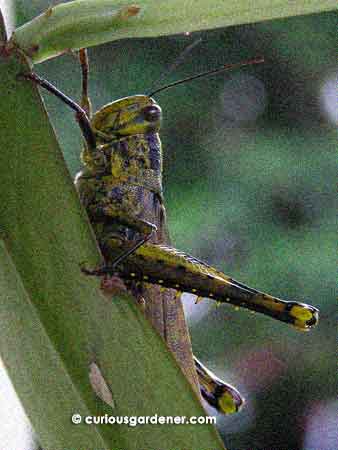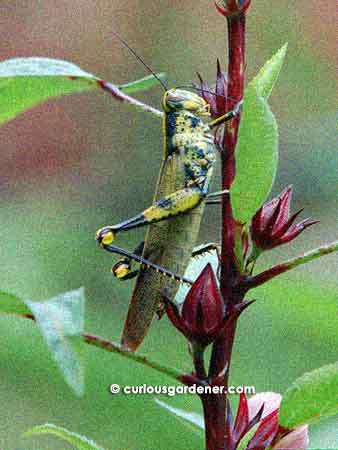A few months ago, my mum, the Keng Hwa queen (so nicknamed because the Keng Hwa plants are her “babies”) noticed a new visitor on one of the Keng Hwa plants.
I thought it was a locust because it was pretty big at about 8cm from head to other end, but online searching did not confirm that, so I’ll resort to calling it a locust until advised otherwise – although they’re both from the grasshopper family.
Whatever insect it really is, it made a re-appearance today, at my roselle plants.
It seemingly nibbled along the stem and some of the young leaves. However, when it left, the stems didn’t look eaten. Could it have been eating little mealy bugs that I couldn’t see? Because those darned bugs were setting up home on the roselle plants, which was why I was there – removing the larger (yuk!) squishy bugs by hand.
Well, it’s wishful thinking on my part, and maybe the locust was indeed feeding on my plant instead of the bugs, but it didn’t like being stalked by a photographer. In a blink of the eye, it shot out of sight with a buzz, like some kind of superhero. Seeing it once was a coincidence. Seeing it a second time says we’ll probably see it again. Maybe by then, I’ll know what to call it.
Addendum to this post, 17 Sept 2011: Thanks to my visitor Pat, I now know that this insect is indeed a grasshopper – an adult female Obscure Birdwing Grasshopper (Schistocerca obscura), to be exact. Scroll on down to the comments for more information. Thanks, Pat! ![]()
© 2011 curiousgardener.com All rights reserved.




It looks scary…
True, but it’s fascinating to look at – the outer shell (exoskeleton?) has got some interesting patterns on it and looks like armour!
From post: “I thought it was a locust because it was pretty big at about 8cm from head to other end, but online searching did not confirm that, so I’ll resort to calling it a locust until advised otherwise; although they’re both from the grasshopper family.”
The ~8cm long creature in your photos appear to be an adult female Schistocerca obscura (Obscure Birdwing Grasshopper). It hails from the Acrididae family of short-horned grasshoppers. Note the colouration: mostly dark olive-green with yellow patches, dark/brownish wings, a yellow/ cream dorsal stripe down its back, 2 dark stripes on its femur, & a yellow spot on the femur-tibia joint. The colour intensity varies with the density of its habitat — more isolated individuals tend to be less vibrantly-coloured.
Some reference photos, as taken in:
* S’pore: Pic1, Pic2
* Indonesia: Pic3
* US: Pic4
Members of the Schistocerca genus are distinctive for their relatively large size. On average, the males range from 35-45mm, while the much larger females range from 50-70+ mm in length.
Schistocerca spp. are also known for their powerful wings & strength of flight. In fact, some species from this genus swarm gregariously under the right conditions — in which case, they are generically known as locusts. (Note: Locusts are basically the *swarming phase* of grasshoppers from the Acrididae family. Hence locusts are the same thing as grasshoppers. These grasshoppers band together as nymphs, & form a locust swarm when they become adults.)
However, Schistocerca obscura is a solitary-type species, & individuals do not congregate to form swarms. This species is native to Southern USA & Mexico, so the specimens sighted in S’pore are introduced aliens (probably carried on plants brought in by the horticulture trade).
Its preferred (but not restrictive) food-plants include trees like Ulmus americanus (American Elm) & Celtis laevigata (Sugar Hackberry), as well as woody/semi-woody shrubs such as Gossypium herbaceum (Cotton Plant). Since Cotton & Hibiscus sabdariffa (Roselle, Ribena Plant) are from the same family (Malvaceae), it is likely that the (herbivorous) grasshopper was attracted to your Roselle plant for the foliage & buds — & not the mealybug insects.
Btw you can remove mealybugs by spraying your affected plants for 2-3 days with a homemade emulsion consisting of dish-washing detergent mixed with water (until the emulsion is slightly soapy to the touch). The detergent kills the mealybugs by dissolving their exoskeleton. However, you would have to repeat the treatment on a periodic basis to prevent repeated infestations.
Hi Pat,
Thanks for giving me the answers I needed! I usually like to write as informative posts as possible, but sometimes I can’t find the answers but want to share what I’ve seen anyway. Now, I understand yet another piece of the puzzle that is the ecological system just outside my door. Thanks for the very comprehensive answer!